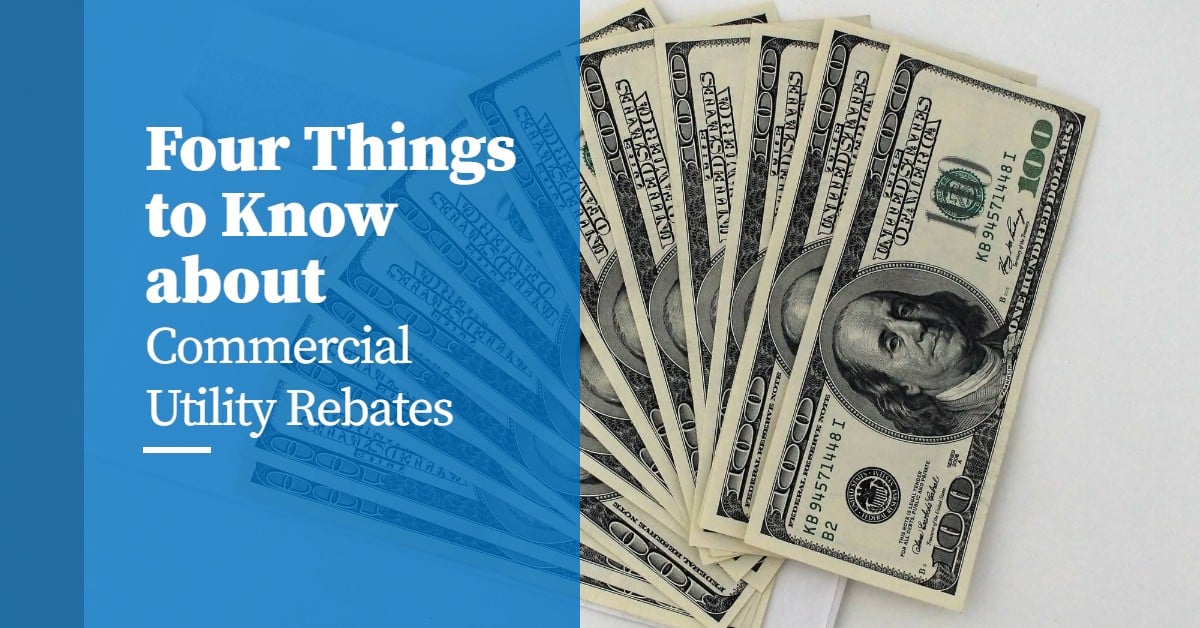
 Posted by Pam Hoddinott
Posted by Pam Hoddinott By Rebecca Lathe, Head of Purchasing and Project Coordination, Chateau Energy Solutions
Are you thinking about upgrading your lighting, HVAC, or control systems to increase energy efficiency? Before you begin, determine if rebates or incentives are available in your area. As the market continues to move towards using energy-efficient equipment, the potential for rebates and incentives continue to increase. Here are a few things you need to know about Commercial Utility Rebates and Incentives.
1. There is a difference between a rebate and an incentive.
When reading about energy efficiency programs, there are times when the terms “rebate” and “incentive” are used interchangeably, and most of the time, they seem to have equal meanings. Care must be taken to understand what the utility is offering since most programs are structured as either an incentive program or a rebate program, not both. When a rebate is received, a portion of an original payment is returned. Contrarily, an incentive is used to entice or motivate action that would not have occurred otherwise. Understanding how a program is structured is essential because if the utility offers incentives instead of rebates and determines that the company had already planned on implementing energy efficiency upgrades, the project could be disqualified from receiving incentives.

2. There are several different types of rebate and incentive programs.
When researching the rebate and incentive programs offered by the utility, keep in mind that the utility may offer several different types of programs. The most common are the instant or midstream program, the prescriptive program, and the custom or performance program.
The instant or midstream program is exactly what it sounds like, an instant rebate. The credit is applied directly to your invoice with no paperwork required. In order to take advantage of an instant rebate, the material must be purchased through an approved distributor.
The prescriptive program is also aptly named because the utility prescribes a certain dollar amount to each measure. For instance, ten 2×4 LED troffers installed with a prescriptive rebate of $15 per troffer would yield $150. Pre-approval may be required before installation can begin. Once the material is installed, the final paperwork is filed, processed, and approved. A post inspection may be required prior to receiving approval. It could take several weeks to receive a check from the utility.
The custom or performance rebate is a little more complicated as it requires more paperwork, takes longer to receive pre-approval, and requires a final inspection, but it tends to yield higher rebates. This type of rebate program depends on how well the installed equipment performs, i.e. how much energy is reduced. The utility will typically offer $/kWh reduced, with the total kWh reduced calculated by determining the proposed kWh and subtracting it from the existing kWh.

Many utilities offer multiple programs, and one project may be able to participate in more than one program. The only restriction is that the same measure cannot be applied to different programs. If you are applying for a lighting rebate, the light bulbs may go through the instant rebate program, while the troffers go through the prescriptive. However, if the lightbulbs do go through the instant program, they cannot also go through the prescriptive, which is called “double dipping”.
3. There are more than 900 rebate and incentive programs nationwide.
With so many programs throughout the United States, the odds are that you can probably take advantage of one of them. Each rebate or incentive program is unique and follows specific guidelines established by the utility, local government, or any third-party entity helping to facilitate the program. Since every program is different, it can be difficult to assess the process and potential of the program. Here are a few basic questions that will help to gain a better understanding of how the program works:
4. There is someone who can help administer and manage the rebate process – your energy management partner.
Often, the company you are working with to implement the energy efficiency projects can also help with the rebate and incentive process. They typically have access to special software that uncovers available incentives and rebates. While rebates and incentives are beneficial, they can be complex and cumbersome. It is important to understand that more complex projects and rollout programs may require a dedicated professional to manage the rebate process. The process can be different for each opportunity and may include identifying the appropriate rebate or incentive, monitoring and verification, post-project inspection, and submitting paperwork within proper timelines.

As you have just learned, rebates and incentives are designed to encourage businesses to reduce their energy consumption, therefore, reducing the strain on the overall grid. They are also quite useful in reducing the payback period of the energy-efficient equipment.
About the Author:
Rebecca Lathe serves as the Head of Purchasing & Project Coordination for Chateau Energy Solutions. She has more than 7 years of experience in the energy and lighting industry. As a Project Coordinator, she sources all materials and labor logistics, providing excellent and personalized customer service, as well as utility incentive/rebate management for energy conservation measures. She has developed and coordinates the project/construction processes for systemizing the execution of projects. Rebecca is central to the Chateau team and works with all departments to ensure projects are completed correctly and efficiently. She can be reached at LinkedIn.
Chateau Energy Solutions Making Energy an Asset®
Ready to get started on the path to energy efficiency and sustainability?